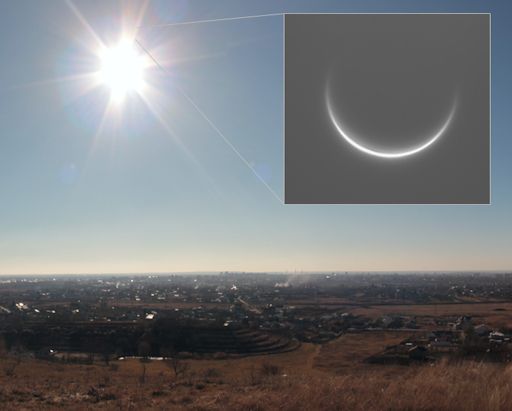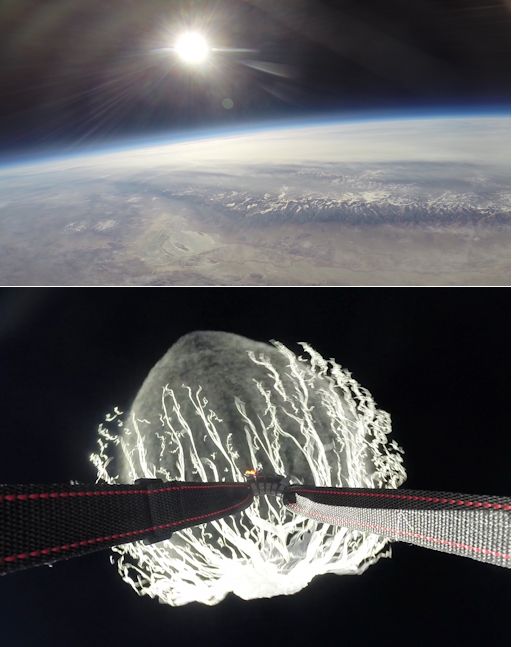Listen to radar echoes from satellites and meteors, live on listener-supported Space Weather Radio. | | |
CHANCE OF FLARES: NOAA forecasters estimate a 35% chance of X-class solar flares on Jan. 11th, most likely from AR1944. The brooding sunspot has been quiet for days, but still poses a threat for strong eruptions. Solar flare alerts: text, voice.
VENUS AT INFERIOR CONJUNCTION: Today, Jan. 11th, Venus is at inferior conjunction. That means it is passing almost directly between Earth and the sun. With its nightside facing Earth (almost perfectly), Venus looks like an incredibly slender crescent. This morning in Targoviste, Romania, amateur astronomer Maximilian Teodorescu photographed Venus only 5 degrees from the sun:

"Taking extreme care not to point any unfiltered optics at the sun, I started to look for Venus through my 11-inch Celestron telescope," says Teodorescu. "The thin but very large crescent suddenly appeared into the field of view. It was surreal to watch the boiling atmospheric arc of the planet just above the sun in plain day. My wife immortalized the moment by taking a panoramic view from our clear-sky location."
Observing Venus through a telescope can be dangerous. Even a quick inadvertent glimpse of magnified light from the nearby sun can cause serious eye damage. Anthony J. Cook of the Griffith Observatory has some advice for observers: "I have observed Venus at conjunction, but only from within the shadow of a building, or by adding a mask to the front end of the telescope to fully shadow the optics from direct sunlight. This is tricky with a refractor or a catadioptric, because the optics start at the front end of the tube. Here at Griffith Observatory, I rotate the telescope dome to make sure the lens of the telescope is shaded from direct sunlight, even through it means that the lens will be partially blocked when aimed at Venus. With our Newtonian telescope, I add a curved cardboard mask at the front end of the tube to shadow the primary mirror."
Around the world, many people are applying these techniques to photograph Venus as it passes by the sun. Browse the gallery to see their amazing results:
Realtime Venus Photo Gallery
SPACE WEATHER BALLOON UPDATE: The payload of a space weather balloon launched Jan. 8th by the students of Earth to Sky Calculus has been recovered from its landing site in Death Valley National Park. The purpose of the flight was to study a solar radiation storm in progress at the time of the launch. Analyzing the data will take a few days. Meanwhile, here is the view from the stratosphere:

These pictures were taken by a pair of Hero3+ cameras looking out of the payload capsule. The upper frame shows the Sierra Nevada mountain range, unusually brown for this time of year as California endures a historic drought. The lower frame captures the balloon popping at an altitude of approximately 100,000 feet. Click on each frame for a closer look. The landscape shot was made using the Hero3+'s new "superview mode"--a favorite of snowboarders and now, for the first time, balloonists!
Update: Here are some more images from tthe flight: A sundog over Owens Valley, Death Valley from the Edge of Space, Coyote Flats.
In addition to cameras, the payload contained an x-ray/gamma-ray dosimeter, a GPS altimeter, and a cryogenic thermometer. Together these instruments can form a complete thermal and radiation profile of the atmosphere throughout the flight. The students plan to pay special attention to data collected at aviation altitudes to learn how much radiation air travelers absorb during periods of high solar activity. Solar flare alerts: text, voice.
Realtime Space Weather Photo Gallery
Realtime Venus Photo Gallery
Realtime Aurora Photo Gallery
Realtime Comet Photo Gallery
Every night, a network of NASA all-sky cameras scans the skies above the United States for meteoritic fireballs. Automated software maintained by NASA's Meteoroid Environment Office calculates their orbits, velocity, penetration depth in Earth's atmosphere and many other characteristics. Daily results are presented here on Spaceweather.com.
On Jan. 11, 2014, the network reported 14 fireballs.
(14 sporadics)

In this diagram of the inner solar system, all of the fireball orbits intersect at a single point--Earth. The orbits are color-coded by velocity, from slow (red) to fast (blue). [Larger image] [movies]
Potentially Hazardous Asteroids (
PHAs) are space rocks larger than approximately 100m that can come closer to Earth than 0.05 AU. None of the known PHAs is on a collision course with our planet, although astronomers are finding
new ones all the time.
On January 11, 2014 there were 1450 potentially hazardous asteroids.
Notes: LD means "Lunar Distance." 1 LD = 384,401 km, the distance between Earth and the Moon. 1 LD also equals 0.00256 AU. MAG is the visual magnitude of the asteroid on the date of closest approach. | | The official U.S. government space weather bureau |
| | The first place to look for information about sundogs, pillars, rainbows and related phenomena. |
| | Researchers call it a "Hubble for the sun." SDO is the most advanced solar observatory ever. |
| | 3D views of the sun from NASA's Solar and Terrestrial Relations Observatory |
| | Realtime and archival images of the Sun from SOHO. |
| | from the NOAA Space Environment Center |
| | the underlying science of space weather |

